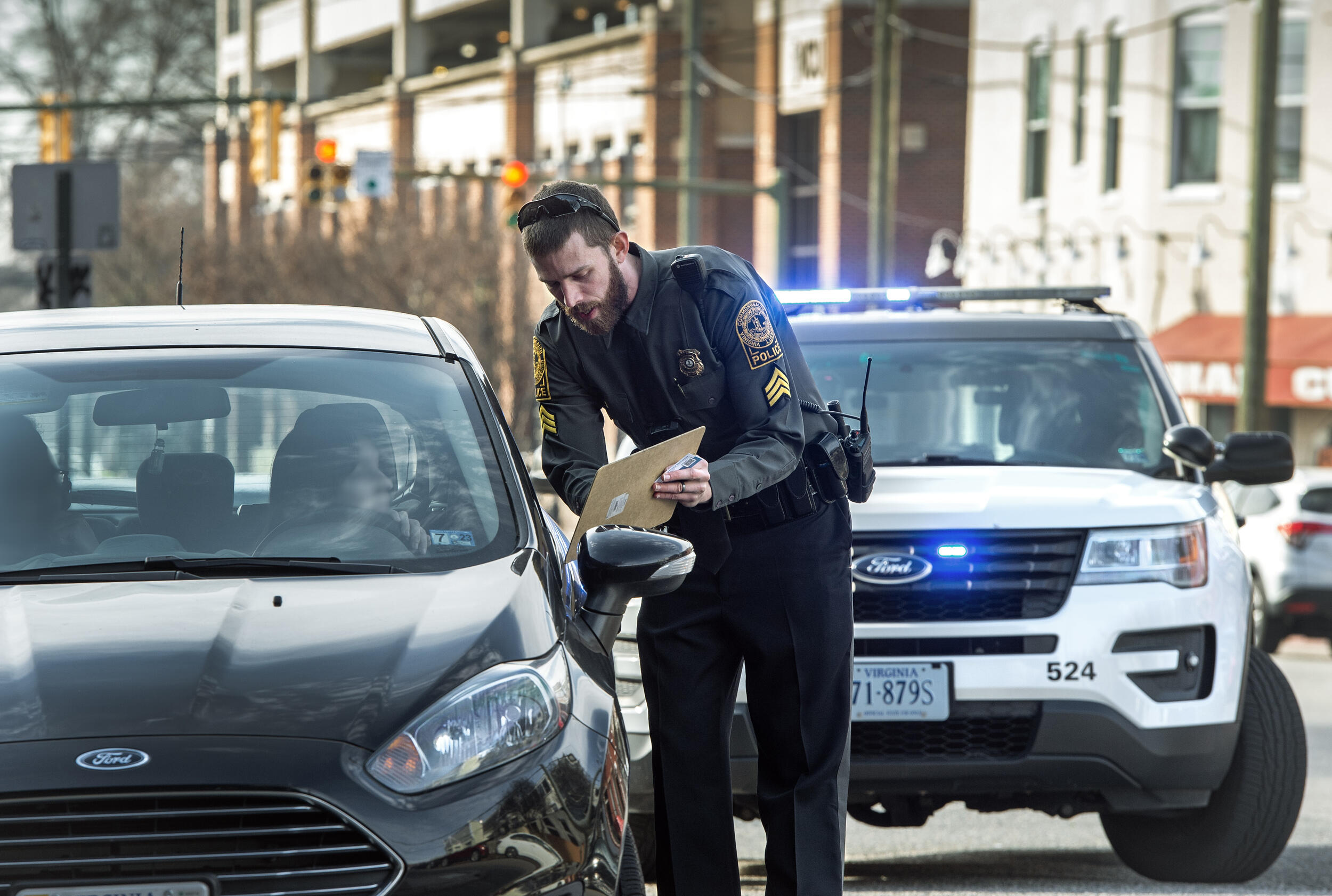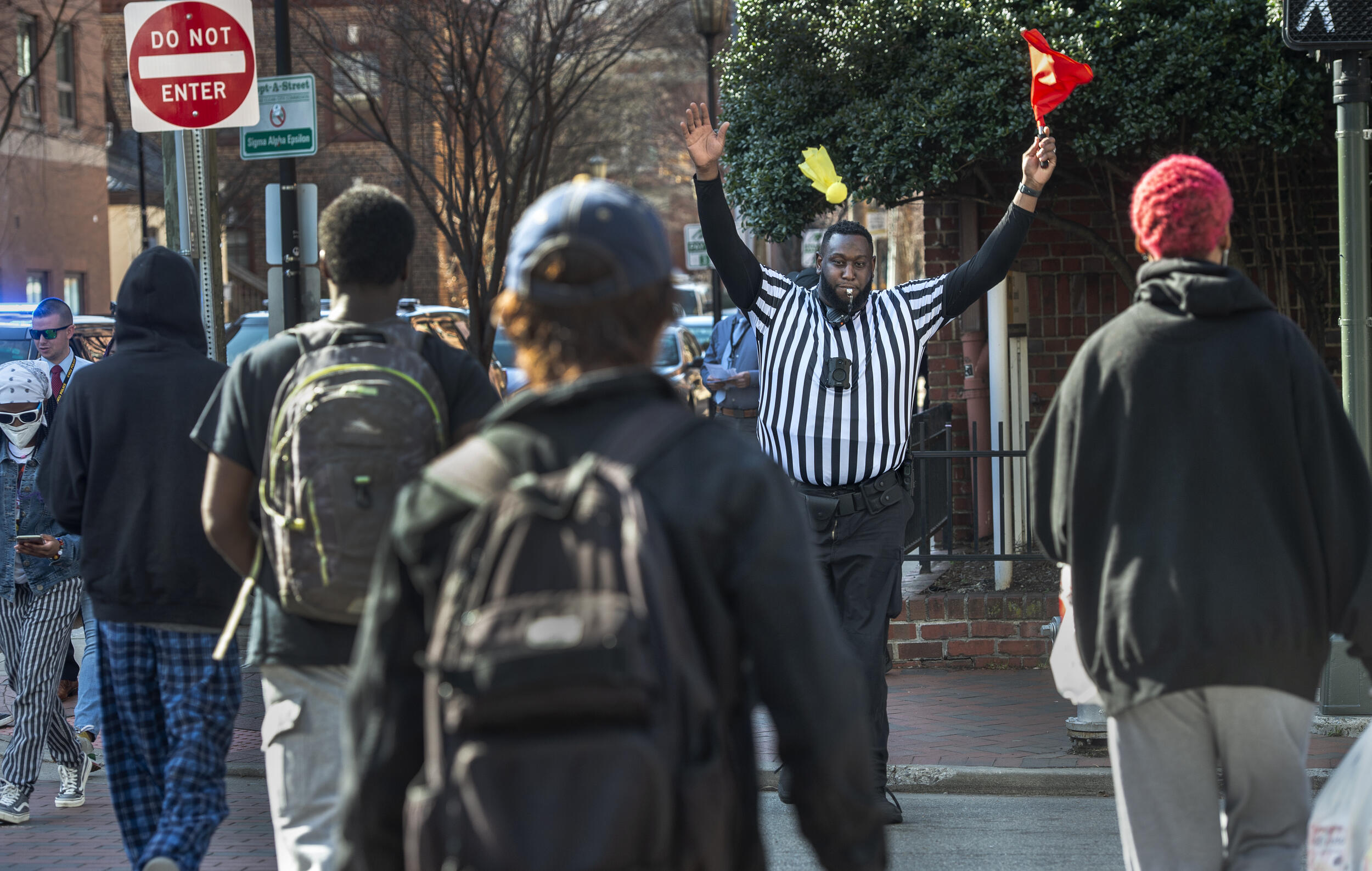
Feb. 8, 2023
VCU Police announce campaign to promote pedestrian, cyclist and driver safety
Share this story
Following the death of student Mahrokh Khan, who was killed in a traffic accident while crossing the street last month, the Virginia Commonwealth University Police Department is increasing the routine enforcement of traffic and parking laws, leading educational outreach for pedestrians, drivers and cyclists and is communicating the importance of traffic safety to the VCU community.
In a recent review of technology systems at VCU, VCU Police have determined that drivers pass through the Monroe Park Campus more than 1 million times in the course of a week.
Added to this number are thousands of cyclists and pedestrians, with everyone using the roadways and intersections 24 hours a day. VCU’s MCV Campus is also extremely busy and is the site for ongoing construction projects.
The goals of the campaign are to encourage safer behaviors by drivers, cyclists and pedestrians and to decrease accidents. Outreach will include officers speaking with community members at crosswalks, hosting outreach events and distributing safety information in VCU’s parking facilities.

Police plan to use creative and innovative tactics to connect with people traveling on both campuses.
On Feb. 8, officers and non-sworn safety ambassadors were stationed at various crosswalks to hand out safety tips to pedestrians. Officers, dressed as referees, used whistles and football-style flags to call out people who tried to cross against the light or who walked outside the crosswalk paint.
“Officers are speaking with community members to raise awareness that everyone plays a role in keeping roads safe,” VCU Police Chief John Venuti said. “Losing a student was deeply upsetting. It’s extremely important that everyone really reconsider their daily travel habits. We all have a responsibility to slow down and take those extra seconds or minutes to get to our destination safely.”
More outreach events are planned for the spring semester.
VCU officials have routinely worked with city officials and other policing agencies to address traffic concerns. Should officers come across areas that may need safety improvements, VCUPD will submit the exact location and concern to the city.
VCU Police will work with the Richmond Police Department and Virginia State Police for select traffic enforcement initiatives.
Below is a summary of VCU Police enforcement operations:
- Officers are looking for drivers who speed, fail to stop at red lights and stop signs and who fail to yield to pedestrians in crosswalks.
- Officers are ticketing and towing illegally parked vehicles, specifically those near the corners of intersections and that obstruct sight lines for pedestrians at crosswalks.
- Cyclists riding on roadways are expected to follow traffic signals and can be ticketed for failing to follow signage and failing to yield the right of way to pedestrians and drivers.
- While pedestrians cannot be ticketed for jaywalking, they can be ticketed for unlawfully entering a roadway and causing an accident.
Police plan to use a variety of communications channels, including VCU News, the daily TelegRAM newsletter, social media and the LiveSafe app to encourage safe travel habits.
“Our initiative is a work in progress, and we are taking an all-hands-on-deck approach,” Venuti said. “We want to thank everyone who has reached out to us with concerns. We hear you and we want to work with the community in every way possible to keep the streets safe.”
General safety tips for drivers, cyclists and pedestrians:
Drivers:
- Buckle up and drive sober.
- Yield to pedestrians in crosswalks, including at unmarked intersections.
- When passing cyclists, give at least 3 feet of passing space and drive at a safe speed.
- Obey posted speed limits.
- Follow traffic signs and signals.
- Use hands-free technology to talk on the phone while driving. (It is illegal for drivers to hold a cell phone while driving. Alternatively, consider using a “do not disturb” setting.)
- Listen to music or audio without using earbuds or headphones.
- Always be aware of your surroundings.
Cyclists:
- When riding on roadways, follow traffic signals and signage.
- Riding a bike on the sidewalk is legal, but you must yield to people walking or rolling.
- Use hand signals.
- If one is available, use a bike path.
- Always be aware of your surroundings; avoid using headphones or earbuds while riding.
- Consider wearing bright/reflective clothing and bike lights, especially at night, to make yourself more visible. (A front light and rear reflector are required after dark, and a red tail light is required on roadways with posted speeds of 35 mph or greater.)
- Wearing a helmet is recommended.
Pedestrians:
- Always be aware of your surroundings; using headphones or earbuds may block sound around you.
- Cross at crosswalks instead of crossing streets mid-block; cross when you have the “walk” light. (If you do not have the “walk light,” stay on the sidewalk if there is oncoming traffic.)
- Look both ways before crossing any crosswalk, intersection or roadway.
- Look up from your phone or electronic device every time you cross a street.
- Consider wearing bright/reflective clothing at night or carrying a flashlight.
Subscribe to VCU News
Subscribe to VCU News at newsletter.vcu.edu and receive a selection of stories, videos, photos, news clips and event listings in your inbox.







